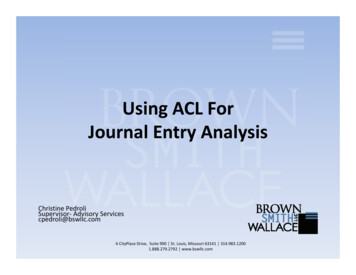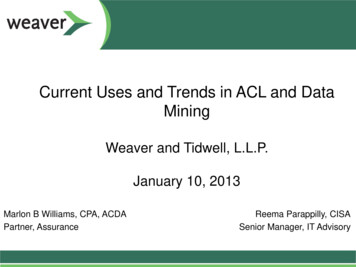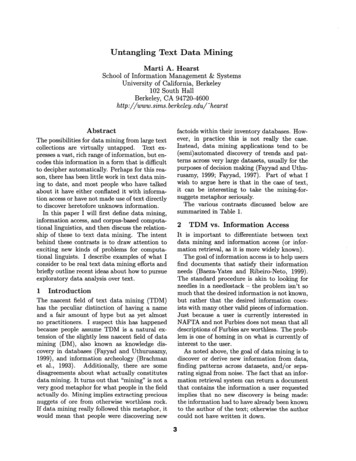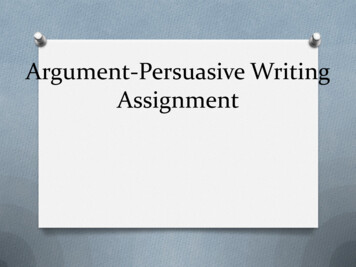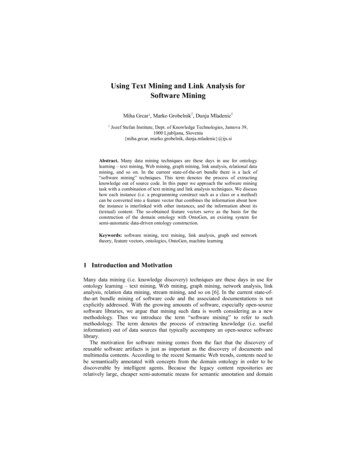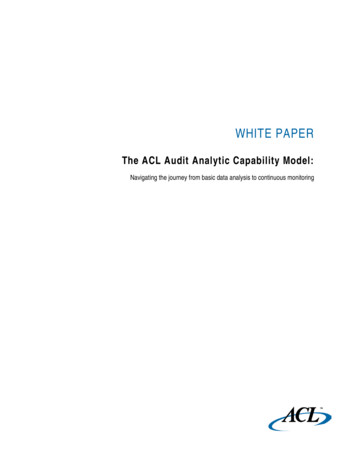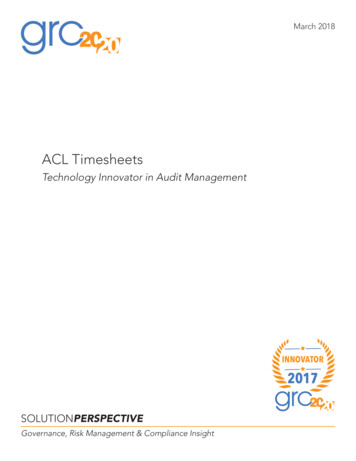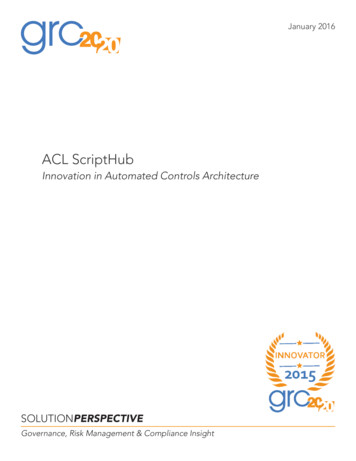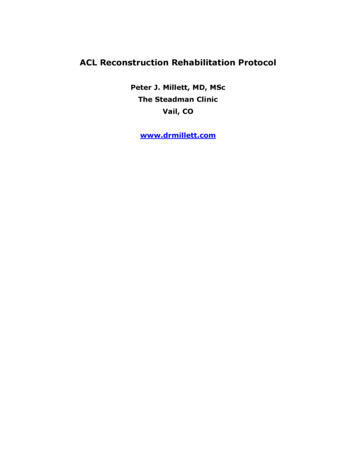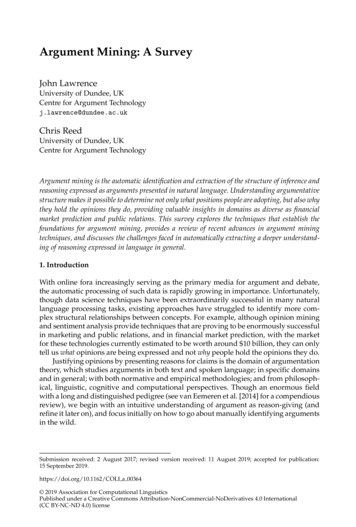
Transcription
Argument Mining: A SurveyJohn LawrenceUniversity of Dundee, UKCentre for Argument Technologyj.lawrence@dundee.ac.ukChris ReedUniversity of Dundee, UKCentre for Argument TechnologyArgument mining is the automatic identification and extraction of the structure of inference andreasoning expressed as arguments presented in natural language. Understanding argumentativestructure makes it possible to determine not only what positions people are adopting, but also whythey hold the opinions they do, providing valuable insights in domains as diverse as financialmarket prediction and public relations. This survey explores the techniques that establish thefoundations for argument mining, provides a review of recent advances in argument miningtechniques, and discusses the challenges faced in automatically extracting a deeper understanding of reasoning expressed in language in general.1. IntroductionWith online fora increasingly serving as the primary media for argument and debate,the automatic processing of such data is rapidly growing in importance. Unfortunately,though data science techniques have been extraordinarily successful in many naturallanguage processing tasks, existing approaches have struggled to identify more complex structural relationships between concepts. For example, although opinion miningand sentiment analysis provide techniques that are proving to be enormously successfulin marketing and public relations, and in financial market prediction, with the marketfor these technologies currently estimated to be worth around 10 billion, they can onlytell us what opinions are being expressed and not why people hold the opinions they do.Justifying opinions by presenting reasons for claims is the domain of argumentationtheory, which studies arguments in both text and spoken language; in specific domainsand in general; with both normative and empirical methodologies; and from philosophical, linguistic, cognitive and computational perspectives. Though an enormous fieldwith a long and distinguished pedigree (see van Eemeren et al. [2014] for a compendiousreview), we begin with an intuitive understanding of argument as reason-giving (andrefine it later on), and focus initially on how to go about manually identifying argumentsin the wild.Submission received: 2 August 2017; revised version received: 11 August 2019; accepted for publication:15 September 2019.https://doi.org/10.1162/COLI a 00364 2019 Association for Computational LinguisticsPublished under a Creative Commons Attribution-NonCommercial-NoDerivatives 4.0 International(CC BY-NC-ND 4.0) license
Computational LinguisticsVolume 45, Number 4Argument analysis aims to address this issue by turning unstructured text intostructured argument data, giving an understanding not just of the individual pointsbeing made, but of the relationships between them and how they work together tosupport (or undermine) the overall message. Although there is evidence that argument analysis aids comprehension of large volumes of data, the manual extraction ofargument structure is a skilled and time-consuming process. For example, Robert Horn,talking about the argument maps he produced on the debate as to whether computerscan think, quotes a student as saying “These maps would have saved me 500 hours oftime my first year in graduate school”; 1 however, Metzinger (1999) notes that over 7,000hours of work was required in order for Horn and his team to create these maps.Although attempts have been made to increase the speed of manual argumentanalysis, it is clearly impossible to keep up with the rate of data being generated acrosseven a small subset of areas and, as such, attention is increasingly turning to argumentmining,2 the automatic identification and extraction of argument components andstructure. The field of argument mining has been expanding rapidly in recent years(with ACL workshops on the topic being held annually, from the first in 2014,3 up to themost recent in 2019,4 which received a record number of 41 submissions. These havebeen complemented by further workshops organized in Warsaw,5 Dundee,6 Dagstuhl,7and tutorials at IJCAI,8 ACL 2016,9 ACL 2019,10 and ESSLLI.11 ) This increasing activitymakes a comprehensive review of both timely and practical value.Previous reviews, including Palau and Moens (2009) and Peldszus and Stede(2013a), predated this explosion in the volume of work in the area, whereas morecontemporary reviews are aimed at different audiences: Budzynska and Villata (2017) atthe computational argumentation community and Lippi and Torroni (2016) at a generalcomputational science audience. Most recently, Stede and Schneider (2018) have, intheir 2018 tour de force, assembled an extensive review of performance on tasks in,and related to, argument mining. Our goal here is to update and extend, introducingreorganization where more recent results suggest different ways of conceptualizing thefield. Our intended audience are those already familiar with computational linguistics,so we spend proportionally more time on those parts of the story that may be lessfamiliar to such an audience, and rather less on things that represent mainstays ofmodern research in computational linguistics. With this goal in mind we also moveon from Stede and Schneider (2018) in three ways. First, we bring the discussion upto date with the newest results based on approaches such as Integer Linear Programming, transfer learning, and new attention management methods, and cover a muchlarger range of data sources: For a discipline that is so increasingly data-hungry, wereview annotated data sources covering over 2.2 million words. Second, we providegreater depth in discussion of foundational topics—covering both the rich heritage ofphilosophical research in the analysis and understanding of argumentation, as well asthose areas and techniques in computational linguistics that lay the groundwork for1234567891011http://www.stanford.edu/ mes also referred to as argumentation w.dagstuhl.de/en/program/calendar/semhp/?semnr 16161.http://www.i3s.unice.fr/ ial.arg.tech/.http://arg.tech/ slli2017/courses/20.766
Lawrence and ReedArgument Mining: A Surveymuch current argument mining work. Thirdly and finally, the simple pipeline view ofargument mining, which characterizes a lot of both older research work and reviews,is increasingly being superceded by more sophisticated and interconnected techniques;here we adopt a more network view of subtasks in argument mining and focus on theinterconnections and dependencies between them.We look first, in Section 2, at existing work in areas that form the foundation formany of the current approaches to argument mining, including sentiment analysis,citation mining, and argumentative zoning. In Section 3 we look at the task of manualargument analysis, considering the steps involved and tools available, as well as thelimitations of manually analyzing large volumes of text. Section 4 discusses the argumentation data available to those working in the argument mining field, as well as thelimitations and challenges that this data presents. In Section 5, we provide an overviewof the tasks involved in argument mining before giving a comprehensive overview ofeach in Sections 6, 7, and 8.2. Foundational Areas and TechniquesIn this section, we look at a range of different areas that constitute precursors to thetask of argument mining. Although these areas are somewhat different in their goalsand approach, they all offer techniques that at least form a useful starting point fordetermining argument structure. We do not aim to present a comprehensive review ofthese techniques in this section, but, instead, to highlight their key features and howthey relate to the task of argument mining.In Section 2.1, we present an overview of opinion mining, focusing specificallyon its connection to argument mining. Section 2.2 looks at Controversy Detection, anextension of opinion mining that aims to identify topics where opinions are polarized.Citation mining, covered in Section 2.3, looks at citation instances in scientific writingand attempts to label them with their rhetorical roles in the discourse. Finally, inSection 2.4, we look at argumentative zoning, where scientific papers are annotated atthe sentence level with labels that indicate the rhetorical role of the sentence (criticismor support for previous work, comparison of methods, results or goals, etc.).2.1 Opinion MiningAs the volume of online user-generated content has increased, so too has the availabilityof a wide range of text offering opinions about different subjects, including product reviews, blog posts, and discussion groups. The information contained within this contentis valuable not only to individuals, but also to companies looking to research customeropinion. This demand has resulted in a great deal of development in techniques toautomatically identify opinions and emotions.Opinion mining is “the computational study of opinions, sentiments, and emotionsexpressed in text” (Liu 2010). The terms “opinion mining” and “sentiment analysis”are often used interchangeably; however, sentiment analysis is specifically limited topositive and negative views, whereas opinion mining may encompass a broader rangeof opinions.The link between sentiment, opinion, and argumentative structure is described inHogenboom et al. (2010), where the role that argumentation plays in expressing andpromoting an opinion is considered and a framework proposed for incorporating information on argumentation structure into the models for economic sentiment discovery767
Computational LinguisticsVolume 45, Number 4in text. Based on their role in the argumentation structure, text segments are assigneddifferent weights relating to their contribution to the overall sentiment. Conclusions,for example, are hypothesized to be good summaries of the main message in a textand therefore key indicators of sentiment. The interesting point here, from an argumentmining perspective, is that this theory could equally be reversed and sentiment be usedas an indicator of the argumentative process found in a text. Taking the example ofconclusions, those segments that align with the overall sentiment of the document aremore likely to be a conclusion than those that do not.Many applications of sentiment analysis are carried out at the document level todetermine an overall positive or negative sentiment. For example, in Pang, Lee, andVaithyanathan (2002), topic-based classification using the two “topics” of positive andnegative sentiment is carried out. To perform this task, a range of different machinelearning techniques (including support vector machines [Cortes and Vapnik 1995],maximum entropy, and naı̈ve Bayes [Lewis 1998]) are investigated. Negation taggingis also performed using a technique from Das and Chen (2001) whereby the tag NOTis prepended to each of the words between a negation word (“not,” “isn’t,” “didn’t,”etc.) and the first punctuation mark occurring after the negation word. In terms ofrelative performance, the support vector machines (SVMs) achieved the best results,with average 3-fold cross-validation accuracies over 0.82 using the presence of unigramsand bigrams as features.Shorter spans of text are also considered in Grosse, Chesñevar, and Maguitman(2012), who look at microblogging platforms such as Twitter with the aim of miningopinions from individual posts to build an “opinion tree” that can be built recursivelyby considering arguments associated with incrementally extended queries. Sentimentanalysis tools are used to determine the overall sentiment for an initial one word query,which is then extended and the change in overall sentiment recalculated. By followingthis procedure, it is possible to see where extending the query results in a change ofoverall sentiment and, as such, to determine those terms that introduce conflict withthe previous query. Conflicting elements in an opinion tree are then used to generatea “conflict tree,” similar to the dialectical trees (Prakken 2005) used traditionally indefeasible argumentation (Pollock 1987).Opinion mining, however, is not limited to just determining positive and negativeviews. In Kim and Hovy (2006b) sentences from online news media texts are examinedto determine the topic and proponent of opinions being expressed. The approach usessemantic role labeling to attach an opinion holder and topic to an opinion-bearing wordin each sentence using FrameNet12 (a lexical database of English, based on manualannotation of how words are used in actual texts). To supplement the FrameNet data, aclustering technique is used to predict the most probable frame for words that FrameNetdoes not include. This method is split into three subtasks:1.Collection of opinion words and opinion-related frames—1,860 adjectivesand 2,011 verbs classified into positive, negative, and neutral. Clustering ByCommittee (Pantel 2003) is used to find the closest frame. This method usesthe hypothesis that words that occur in the same context tend to be similar.2.Semantic role labeling for those frames. A maximum entropy model isused to classify frame element types (Stimulus, Degree, Experiencer, etc.)12 https://framenet.icsi.berkeley.edu/.768
Lawrence and Reed3.Argument Mining: A SurveyMapping of semantic roles to the opinion holder and topic. A manuallybuilt mapping table maps Frame Elements to a holder or topic.Results show an increase from the baseline of 0.30 to 0.67 for verb target words andof 0.38 to 0.70 for adjectives, with the identification of opinion holders giving a higherF-score13 than topic identification.Although understanding the sentiment of a document as a whole could be a usefulstep in extracting the argument structure, the work carried out on sentiment analysis at afiner-grained level perhaps offers greater benefit still. In Wilson, Wiebe, and Hoffmann(2005), an approach to phrase-level sentiment analysis is presented, using a two-stepprocess: first, applying a machine learning algorithm to classify a phrase as either neutral or polar (for which an accuracy of 0.76 is reported); and then looking at a variety offeatures in order to determine the contextual polarity (positive, negative, both, or neutral)of each polar phrase (with an accuracy of 0.62–0.66, depending on the features used).In Sobhani, Inkpen, and Matwin (2015), we see an example of extending simple proand con sentiment analysis, to determine the stance which online comments take towardan article. Each comment is identified as “Strongly For,” “For,” “Other,” “Against,” and“Strongly Against” the original article. These stances are then linked more clearly to theargumentative structure by using a topic model to determine what is being discussedin each comment, and classify it to a hierarchical structure of argument topics. Thiscombination of stance and topic hints at possible argumentative relations—for example,comments about the same topic that have opposing stance classifications are likely tobe connected by conflict relations, whereas those with similar stance classifications aremore likely to connect through support relations.In Kim and Hovy (2006a), the link between argument mining and opinion mining isclearer still. Instead of looking solely at whether online reviews are positive or negative,a system is developed for extracting the reasons why the review is positive or negative.Using reviews from epinions.com, which allows a user to give their review as well asspecific positive and negative points, these specific positive and negative phrases werefirst collected and then the main review searched for sentences that covered most of thewords in the phrase. Using this information, sentences were classified as “pro” or “con”with unmatched sentences classified as “neither.” Sentences from further reviews werethen classified as, first, “pro” and “con” against “neither” followed by classificationinto “pro” or “con.” The best feature selection results in an F-score of 0.71 for reasonidentification and 0.61 for reason classification.2.2 Controversy DetectionOne extension to the field of opinion mining that has particular relevance to argumentmining is controversy detection, where the aim is to identify controversial topics andtext where conflicting points of view are being presented. The most clear link betweencontroversy and argument detection can be seen in Boltužić and Šnajder (2015), whereargumentative statements are clustered based on their textual similarity, in order toidentify prominent arguments in online debates. Controversy detection to date has13 F-score refers to the equally weighted harmonic mean of the precision and recall measured for a system.When the system is applied to several sets of data, the micro-average F-score is obtained by firstsumming up the individual true positives, false positives, and false negatives and then calculatingprecision and recall using these figures, whereas the macro-average F-score is calculated by averaging theprecision and recall of the system on the individual sets (van Rijsbergen 1979).769
Computational LinguisticsVolume 45, Number 4largely targeted specific domains: Kittur et al. (2007), for example, look at the costof conflict in producing Wikipedia articles, where conflict cost is defined as “excesswork in the system that does not directly lead to new article content.” Conflict revisioncount (CRC), a measure counting the number of revisions in which the “controversial”tag was applied to the article, is developed and used to train a machine learningmodel for predicting conflict. Computing the CRC for each revision of every articleon Wikipedia resulted in 1,343 articles for which the CRC score was greater than zero(meaning they had at least one “controversial” revision). Of these, 272 articles wereadditionally marked as being controversial in their most recent revision. A selectionof these 272 articles is then used as training data for an SVM classifier. Features arecalculated from the specific page such as the length of the page, how many revisionswere carried out, links from other articles, and the number of unique editors. Of thesefeatures, the number of revisions carried out is determined to be the most importantindicator of conflict; and by predicting the CRC scores using a combination of pagemetrics, the classifier is able to account for approximately 90% of the variation in scores.It is reasonable to assume that the topics covered on those pages with a high CRC arecontroversial and, therefore, topics for which more complex argument is likely to occur.The scope of controversy detection is broadened slightly in Choi, Jung, and Myaeng(2010) and Awadallah, Ramanath, and Weikum (2012), who both look at identifyingcontroversy in news articles. In Choi, Jung, and Myaeng (2010), a controversial issue isdefined as “a concept that invokes conflicting sentiments or views” and a subtopic as“a reason or factor that gives a particular sentiment or view to the issue.” A method isproposed for the detection of controversial issues, based on the magnitude of sentimentinformation and the difference between the magnitudes for two different polarities.First, noun and verb phrases are identified as candidate issues using a mixture ofsentiment models and topical information. The degree of controversy for these issuesis calculated by measuring the volume of both positive and negative sentiment andthe difference between them. For subtopic extraction, noun phrases are identifiedas candidates and, for these phrases, three statistical features (contextual similaritybetween the issue and a subtopic candidate, relatedness of a su
mining,2 the automatic identification and extraction of argument components and structure. The field of argument mining has been expanding rapidly in recent years (with ACL workshops on the topic being held annually, from the first in 2014,3 up to the most recent in 2019,4 whi
